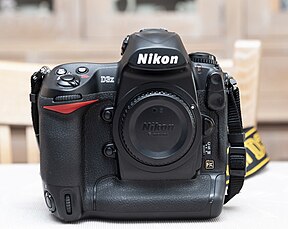The Nikon D3X is a 24.4-megapixel professional-grade full-frame digital single-lens reflex camera (DSLR) announced by the Nikon Corporation on 1 December 2008.[1] The D3X is the third camera in Nikon's line to offer a full-frame sensor, following the D3 and D700. As Nikon's new flagship model, it augments the Nikon D3S, Nikon's high-speed professional model, and while the D3S retains advantages in terms of high ISO performance and higher frame rate, the D3X offers a dramatic increase in resolution and image detail.[2]
 | |
| Overview | |
|---|---|
| Type | Digital single-lens reflex camera |
| Released | 1 December 2008 |
| Intro price | $7,999.95 |
| Lens | |
| Lens | Interchangeable, Nikon F-mount |
| Sensor/medium | |
| Sensor | 35.9 mm × 24 mm CMOS, Nikon FX format, 5.95µm pixel size |
| Maximum resolution | 6048 × 4032 pixels (24.4 megapixels) |
| Film speed | ISO equivalency 100 to 1600 in 1/3, 1/2 or 1.0 EV steps, Boost: 50–6400 in 1/3, 1/2 or 1.0 EV steps |
| Recording medium | Two CompactFlash (Type I or Type II) & MicroDrive card slots |
| Focusing | |
| Focus modes | Single-servo AF (S), Continuous-servo AF (C), Manual |
| Focus areas | 51-area Nikon Multi-CAM 3500FX |
| Focus bracketing | none |
| Exposure/metering | |
| Exposure modes | Programmed Auto [P], Shutter-Priority Auto [S], Aperture-Priority Auto [A], Manual [M] |
| Exposure metering | TTL full aperture exposure metering system |
| Metering modes | 1,005-pixel RGB 3D Color Matrix Metering II, Variable Center-Weighted, Spot AF |
| Flash | |
| Flash | n/a |
| Flash bracketing | n/a |
| Shutter | |
| Shutter | Electronically controlled vertical-travel focal-plane shutter |
| Shutter speed range | 30 to 1/8000 second and bulb |
| Continuous shooting | 5 frame/s (7 frame/s in DX crop mode) |
| Viewfinder | |
| Viewfinder | Optical-type fixed eye level pentaprism |
| Image processing | |
| White balance | Auto, Presets (5), Manual, and Color temperature in kelvins |
| WB bracketing | 2 to 9 frames, 10,20,30 MIRED steps |
| General | |
| LCD screen | 3-inch diagonal, 307,000 pixels (920,000 dots), TFT VGA |
| Battery | Li-ion EN-EL4a |
| Optional battery packs | EH-6 AC Adapter |
| Weight | 1,220 g (2.69 lb) |
| Made in | |
The D3S and D3X follow the earlier Nikon D1, Nikon D2H, Nikon D2Hs, Nikon D2X, Nikon D2Xs, and Nikon D3 as the company's top-of-the-line DSLRs intended for professional photographers, which in turn share a lineage with the Nikon F through Nikon F6 series of film SLRs.
Features
editIt otherwise offers nearly all the features of the D3S, including robust weather-sealed alloy-body construction and a built-in vertical grip. Its Nikon EXPEED image processor features automatic correction of lateral chromatic aberration, and vignetting ("vignette control") and lens distortion ("distortion"), as well as image rotation ("straighten") via playback ("retouch") menu and in camera 5:4 aspect ratio cropping.
Reception
editThe combination of very high resolution with the option of 14-bit per channel recording and a very sharp anti-aliasing filter (which Nikon claims is a unique design) provides extremely high image quality,[3] with superior dynamic range and color accuracy compared with that of other 35mm-format digital cameras.[4]
Reception of the Nikon D3X by independent reviewers has been very positive, with reservations centered on just a few disadvantages, especially its high price. Imaging Resource concludes that the D3X produces the highest image quality of any camera they have tested to date.[5] Digital Photography Review likewise concludes that the resolution and image detail is stunning, probably the best of any digital SLR camera on the market, including the closest competitor from Canon, the EOS-1Ds Mark III.[2] Nikon claims the D3X is a competitor to medium-format digital backs,[6] a claim supported both by testing [3] and by many D3X users who report on their experiences online. On the down side, Digital Photography Review notes that the D3X performs worse than the D3 in terms of speed (frame rate) and high ISO performance.[2] Like many reviewers, they also point out the most obvious disadvantage of the D3X: the camera lists for $8000, though the present market price is much lower.[7]
The Nikon D3X has been tested by many other independent reviewers.[8][9][10][11] Sample images with many cameras at all ISO speeds can be compared.[12] In May 2009, the D3X won the TIPA European Photo & Imaging Award, in the "Best D-SLR Professional" category.[13]
References
edit- ^ "Digital SLR Camera Nikon D3X". Nikon. December 1, 2008. Retrieved December 16, 2009.
- ^ a b c Rehm, Lars (February 19, 2009). "Nikon D3x Review: 33. Conclusion". Digital Photography Review. Retrieved December 16, 2009.
- ^ a b "Detailed image quality data for Nikon D3X". DxO Mark. Retrieved December 16, 2009.
- ^ "Camera Rankings". DxO Mark. Archived from the original on December 8, 2009. Retrieved December 16, 2009.
- ^ Michael R. Tomkins, Dave Etchells and Siegfried Weidelich (July 23, 2009). "Nikon D3X Digital Camera – Full Review". The Imaging Resource. Retrieved December 16, 2009.
- ^ "Nikon D3X Brochure" (PDF). Nikon Corporation. Archived from the original (PDF) on February 16, 2010. Retrieved December 16, 2009.
- ^ Google product search: Nikon D3X
- ^ "Nikon D3X – Digital Camera Reviews". Digital Camera Tracker. Archived from the original on April 7, 2010. Retrieved January 7, 2010.
- ^ "Nikon D3X review summary". Dcviews. Retrieved January 7, 2010.
- ^ D3S & D3X SLR review links Nikonlinks
- ^ "Nikon D3X Digital Camera Review". DigitalCameraInfo.com. Archived from the original on 21 January 2013. Retrieved 26 July 2011.
- ^ Imaging Resource Comparometer (needs Javascript enabled)
- ^ "Nikon D3X and D90 Honored with TIPA European Photo & Imaging Awards". Nikon news archive. Nikon Corporation. May 7, 2009. Archived from the original on January 14, 2010. Retrieved December 16, 2009.